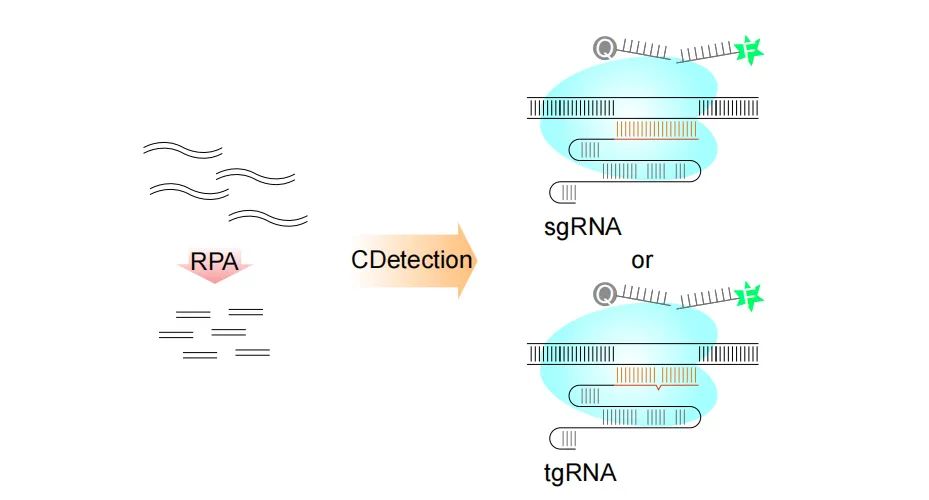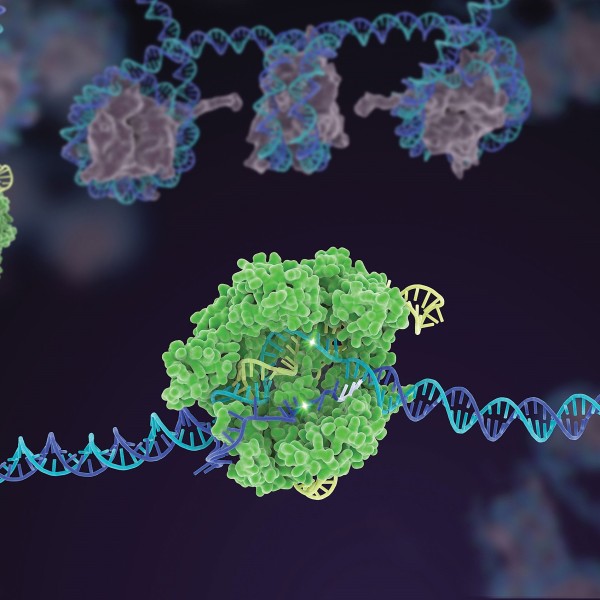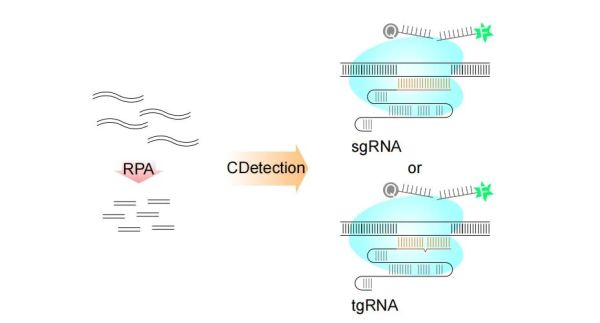The CRISPR/Cas system was a mechanism in bacteria to defend against viral invasion. Some Cas protein can not only recognize and cleave target genes, but also non-specifically cleave ssDNA or ssRNA within the system (known as collateral cleavage). Therefore, the CRISPR/Cas system can be widely used in Nucleic Acid Detection.
Compared to other CRISPR/Cas systems used for Nucleic Acid Detection, Cas12b can tolerate a wider range of temperatures (4-70°C) and pH values (pH 4-10), as well as a shorter PAM sequence(TTN) indicated that Cas12b could be suitable within more sequences .This means that Cas12b is easier to store and transport, and can adapt to a variety of nucleic acid detection conditions.
SynsorBio has integrated the recombinase polymerase amplification(RPA) technology and CRISPR/Cas nucleic acid detection technology into a single reaction system. This solution solves the dependency of traditional nucleic acid detection techniques (such as real-time fluorescence quantitative PCR) on complex instruments (real-time fluorescence quantitative PCR detection instruments) and laboratory environments (PCR laboratories).

◆ High Performance AaCas12b for CRISPR Detection
SynsorBio provids a High Activity Cas12b(C2C1), which reaction buffer highly optimized for maximum efficiency. In the optimized reaction volume, direct color visualized reporting is available. Our Cas12b exhibits excellent temperature stability and compatible with LAMP reactions. On the other hand, it can be stored in liquid form or as a dried product, particularly useful for the development of In Vitro Diagnostics (IVD) assay systems.

- Reaction condition: 43℃; SLAN-48P platform; 150ng sgRNA; 0.6μM fluorescence probe; 10^9 copies Target strand oligo;
◆ Great Sensitivity and Specificity — Bst 4.0 for RT-LAMP
The engineered protein, derived from Bacillus stearothermophilus DNA Polymerase I, has been modified to remove 5'-3' exonuclease activity, resulting in improved strand displacement ability, impurity tolerance, and RT activity. It is an exceptional enzyme for Isothermal Amplification (LAMP), offering significant enhancements in amplification speed, specificity, yield, salt tolerance, and thermal stability compared to wild-type Bst DNA polymerase.
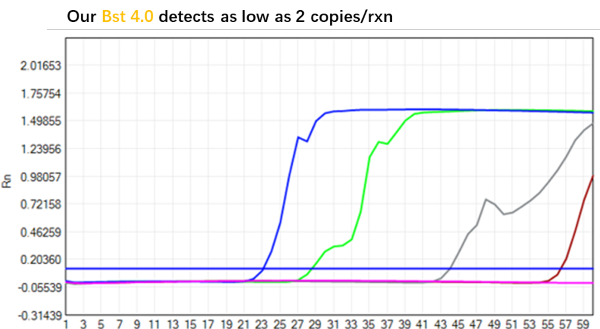
Bacteriophage MS2 target RT-LAMP Amplification plot of 2000, 200, 20, 2, 0 copies/rxn
- Duration: 60min; Reaction condition: 65 ℃; Equipment: SLAN-48P; 16U Bst 4.0; SYBR Green fluorescent Dye;
◆ Validation of One-Step RPA-CRISPR Detection System
Based on the RPA amplification, CRISPR and reaction volume optimization, SynsorBio has developed a novel one-stop RPA-CRISPR detection system. All reaction reagent was stablized in the reaction consumables. During the operation, operators simple need to add the samples and mix. This one-pot RPA-CRISPR system could distinguish the signal of the sample as low as 10 copies/test within 10min.
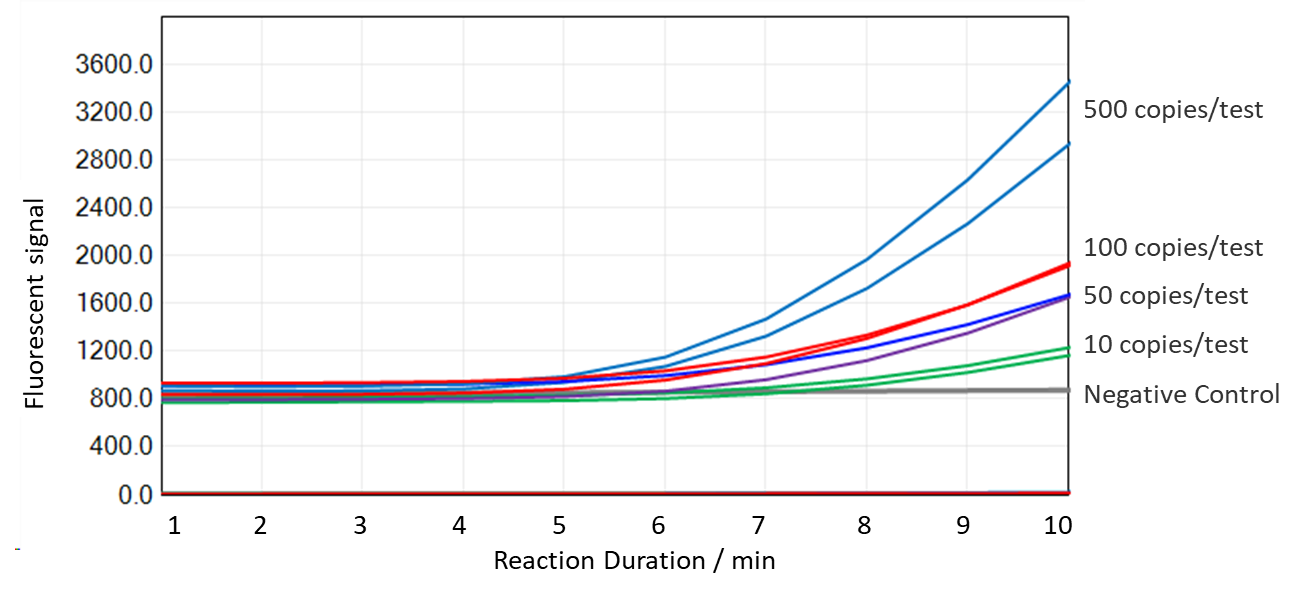
This reaction consumable contains 3 major contents, RPA enzyme mix (Lyophilized Bead), RPA buffer (powder) and CRISPR reagent (powder). During the experiment, all you should do is add the lysis sample into the tube and shake well.
◆ Visualization Validation of CRISPR System
The visual methodology based on RPA and CRISPR from SynsorBio could generate the distinguishable results within 30min, while the sensitivity was comparable to qPCR (as low as 5 copy/test).

- Duration: RPA 10min with CRISPR 20min; Reaction condition:43℃; Equipment: SLAN-96P; 150ng sgRNA and 7.5 μM fluorescence probe.
# Supports OEM & ODM
| Cat. No. | Product Name | Amount | Size |
| XS-R-002-1 | SynSor AaCas 12b(C2c1) | 200 pmol | 80 μL,40 T/Box |
| XS-R-002-2 | SynSor AaCas 12b(C2c1) | 2000 pmol | 800 μL,400 T/Box |
| XS-R-003-1 | SynSor LbCas 12a(Cpf1) | 200 pmol | 80 μL,40 T/Box |
| XS-R-003-2 | SynSor LbCas 12a(Cpf1) | 2000 pmol | 800 μL,400 T/Box |
| XS-R-005-1 | SynSor LwaCas 13a(C2c2) | 200 pmol | 80 μL,40 T/Box |
| XS-R-005-2 | SynSor LwaCas 13a(C2c2) | 1000 pmol | 400 μL,200 T/Box |
| XS-R-101 | SynSor DNA/RNA Isothermal Rapid Amplification Reagents | 48 T/Box | 48 T/Box |
| XS-R-102 | SynSor CRISPR Single-Target Test Strip(FAM-Biotin) | 50 T/Can | 50 T/Can |
| XS-R-201 | SynSor CRISPR ssDNA Reporter(12b-FAM) | 2 OD/Box | 500 T/Tube |
| XS-R-202 | SynSor CRISPR ssDNA Reporter(12a-FAM) | 2 OD/Box | 500 T/Tube |
| XS-R-203 | SynSor CRISPR ssRNA Reporter(13a-FAM) | 2 OD/Box | 500 T/Tube |
| XS-R-204 | SynSor CRISPR ssDNA Reporter(FAM-Biotin) | 2 OD/Box | 2000 T |
| XS-R-301 | SynSor sgRNA | 1.5 nmol/Box | 500 T |



